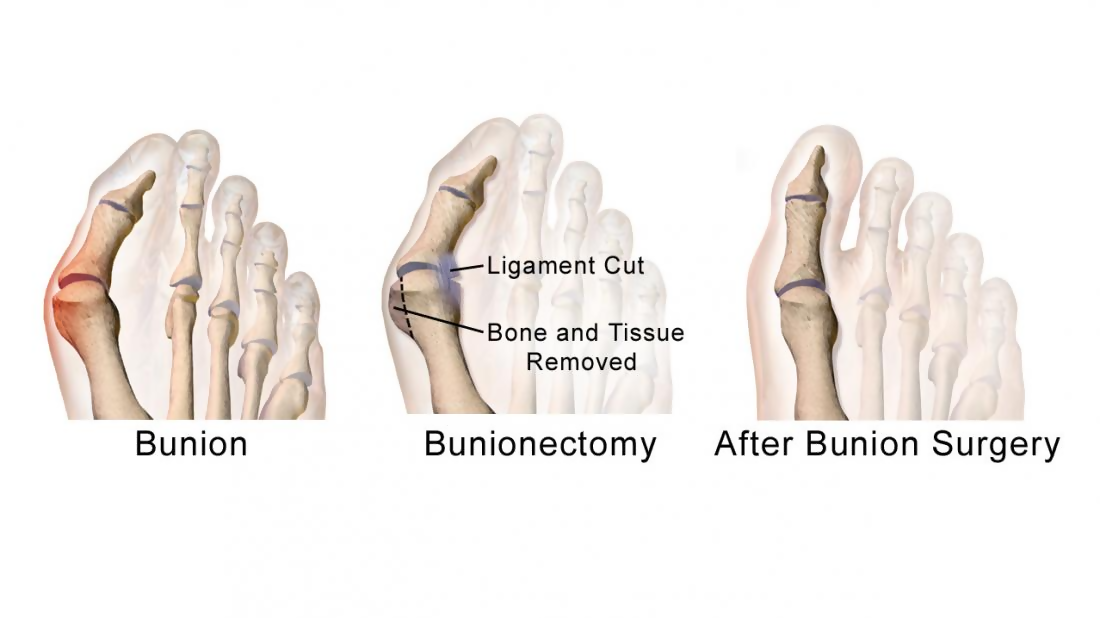
A bunion, usually a bony bump, that forms on the joint of the big toe. It means that some bones at the front of the foot have moved out of place, causing the big toe to pull towards the smaller toes, forcing the joint to stick out. The area around the joint is red and sore. The most obvious symptom of a bunion is a bulging lump at the joint of the toe. Avoid bunion surgery by seeking solutions immediately you notice bunion symptoms.
Causes of bunions
The exact cause of bunions is not known, but other likely reasons are
- Foot deformities at birth.
- Inherited foot type.
- Foot injuries and stresses.
- Some bunions have been linked to inflammatory rheumatoid arthritis.
- Tight or too-narrow shoes or high-heeled shoes cause bunions though some experts disagree with this.
Other factors that increase the risk of developing bunions are:
- Wearing high heels is believed to be the number one risk factor. High heels force the toes to the front of the shoes causing the toes to cramp.
- Wearing too narrow or tight shoes, likely pointed, cause bunions due to pressure on the toes cramped together.
- The tendency to develop bunions might be a result of inherited anatomy or structure of the foot.
- If you have an underlying condition, such as rheumatoid arthritis, it likely favors the development of bunions.
- Adolescents, especially girls, are likely to get bunions. It is not known why, but doctors suspect the constant need to change footwear around this age as a contributing factor. However, bunions in adolescents and young people have not been linked to any underlying health condition.
- Bunionette forms at the little toe’s joint, often known as a tailor’s bunion, is caused by the pressure put on the side of the foot. It often happens due to sitting cross-legged for long hours, putting pressure on the side of the foot leading to bunions near the pinky toes.
Unless you seek bunion treatment Houston, bunions are permanent. However, several measures will make you comfortable and slow bunion progression. Some measures include
- Maintain a healthy weight that does not put pressure on your feet.
- Buy the gel-filled pad or moleskin from a drugstore for the protection of the bunion. You need to test the moleskin for a short time to determine if it helps ease pressure and pain.
- Buy over-the-counter arch supports or shoe inserts that will position the foot correctly.
- Following your podiatrist’s guidance, use a splint at night to ease the discomfort and hold the toe straight.
- Take pain killers that are anti-inflammatory such as ibuprofen.
- Use massage, warm soaks, and icepacks regularly. If you have circulation problems, consult the foot doctor before using an icepack.
- Buy proper fitting shoes with a wide toe box with room for your toes. The heels of the shoes should be lower than two inches.
Immediately you notice changes in the structure of the toe or foot, visit a bunion doctor to avoid complications such as stiff toe, chronic toe pain, and foot/toe deformity.
Over at DeNiel Foot and Ankle Center located in Houston, Texas, and covering surrounding areas like Cypress, and Katy, TX. Ejodamen Shobowale, DPM and her highly skilled staff provide personalized comprehensive care for all your podiatry and sport medicine needs. Whether the issue is foot-related like hammertoes, or toenail fungus or involves pain in the heel , nerves, or joints, Dr. Sho, as she is fondly called, can get you back on your feet in no time.